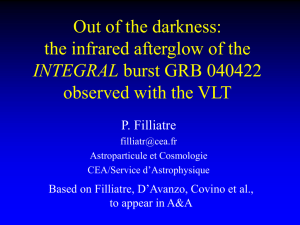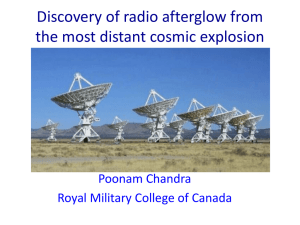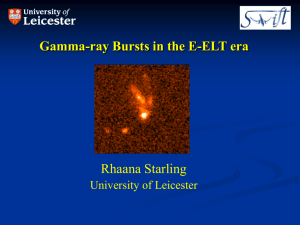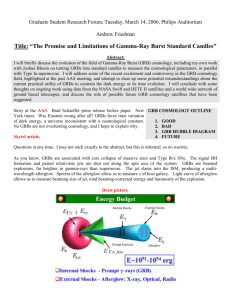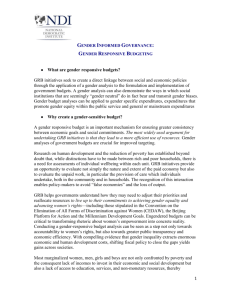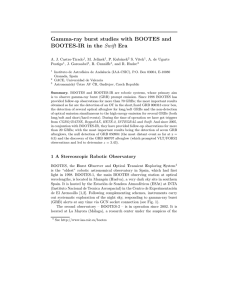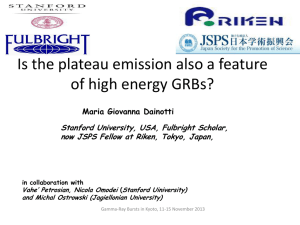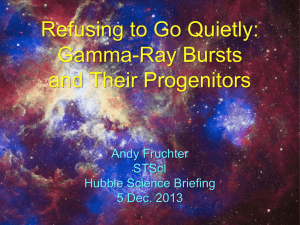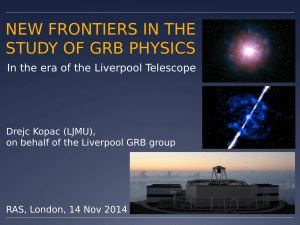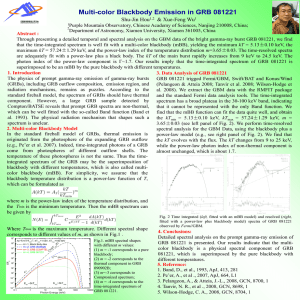File - Department of Physics, HKU
advertisement
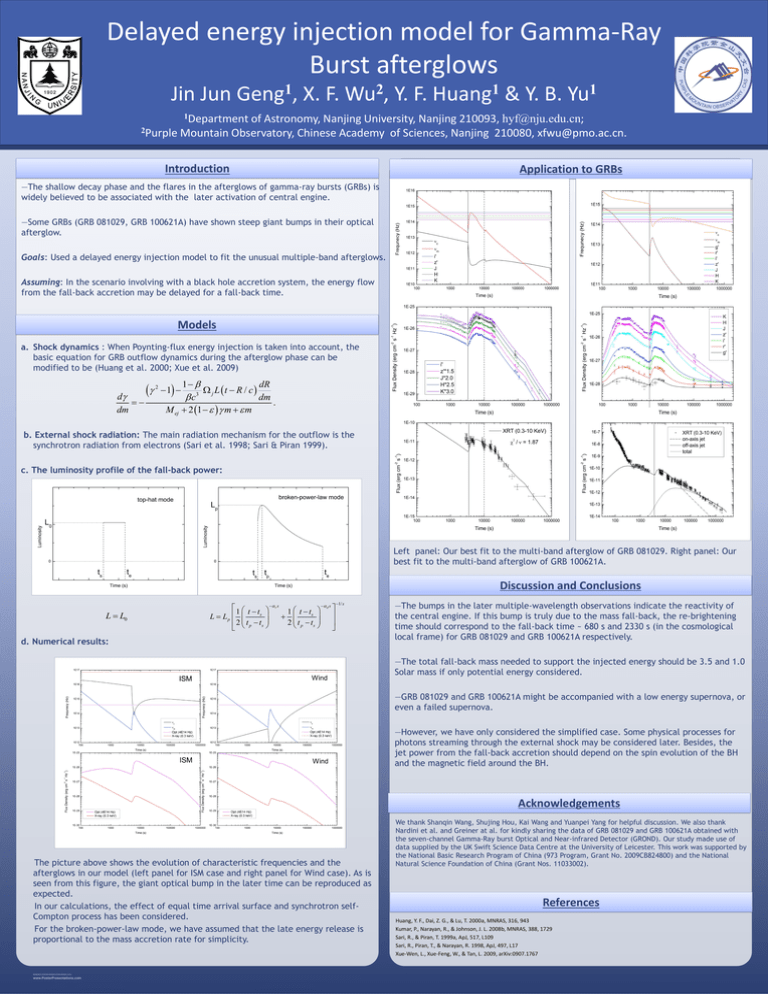
Delayed energy injection model for Gamma-Ray Burst afterglows Jin Jun 1 Geng , X. F. 2 Wu , Y. F. 1 Huang & Y. B. 1 Yu 1Department of Astronomy, Nanjing University, Nanjing 210093, hyf@nju.edu.cn; 2Purple Mountain Observatory, Chinese Academy of Sciences, Nanjing 210080, xfwu@pmo.ac.cn. Introduction Application to GRBs ―The shallow decay phase and the flares in the afterglows of gamma-ray bursts (GRBs) is widely believed to be associated with the later activation of central engine. ―Some GRBs (GRB 081029, GRB 100621A) have shown steep giant bumps in their optical afterglow. Goals: Used a delayed energy injection model to fit the unusual multiple-band afterglows. Assuming: In the scenario involving with a black hole accretion system, the energy flow from the fall-back accretion may be delayed for a fall-back time. Models a. Shock dynamics : When Poynting-flux energy injection is taken into account, the basic equation for GRB outflow dynamics during the afterglow phase can be modified to be (Huang et al. 2000; Xue et al. 2009) 1 dR 1 3 j L t R / c d c dm . dm M ej 2 1 m m 2 b. External shock radiation: The main radiation mechanism for the outflow is the synchrotron radiation from electrons (Sari et al. 1998; Sari & Piran 1999). c. The luminosity profile of the fall-back power: Left panel: Our best fit to the multi-band afterglow of GRB 081029. Right panel: Our best fit to the multi-band afterglow of GRB 100621A. Discussion and Conclusions L L0 1 t t s L Lp 2 t p ts r s 1 t ts 2 t p ts d s 1/ s d. Numerical results: ―The bumps in the later multiple-wavelength observations indicate the reactivity of the central engine. If this bump is truly due to the mass fall-back, the re-brightening time should correspond to the fall-back time ~ 680 s and 2330 s (in the cosmological local frame) for GRB 081029 and GRB 100621A respectively. ―The total fall-back mass needed to support the injected energy should be 3.5 and 1.0 Solar mass if only potential energy considered. ―GRB 081029 and GRB 100621A might be accompanied with a low energy supernova, or even a failed supernova. ―However, we have only considered the simplified case. Some physical processes for photons streaming through the external shock may be considered later. Besides, the jet power from the fall-back accretion should depend on the spin evolution of the BH and the magnetic field around the BH. Acknowledgements The picture above shows the evolution of characteristic frequencies and the afterglows in our model (left panel for ISM case and right panel for Wind case). As is seen from this figure, the giant optical bump in the later time can be reproduced as expected. In our calculations, the effect of equal time arrival surface and synchrotron selfCompton process has been considered. For the broken-power-law mode, we have assumed that the late energy release is proportional to the mass accretion rate for simplicity. RESEARCH POSTER PRESENTATION DESIGN © 2012 www.PosterPresentations.com We thank Shanqin Wang, Shujing Hou, Kai Wang and Yuanpei Yang for helpful discussion. We also thank Nardini et al. and Greiner at al. for kindly sharing the data of GRB 081029 and GRB 100621A obtained with the seven-channel Gamma-Ray burst Optical and Near-infrared Detector (GROND). Our study made use of data supplied by the UK Swift Science Data Centre at the University of Leicester. This work was supported by the National Basic Research Program of China (973 Program, Grant No. 2009CB824800) and the National Natural Science Foundation of China (Grant Nos. 11033002). References Huang, Y. F., Dai, Z. G., & Lu, T. 2000a, MNRAS, 316, 943 Kumar, P., Narayan, R., & Johnson, J. L. 2008b, MNRAS, 388, 1729 Sari, R., & Piran, T. 1999a, ApJ, 517, L109 Sari, R., Piran, T., & Narayan, R. 1998, ApJ, 497, L17 Xue-Wen, L., Xue-Feng, W., & Tan, L. 2009, arXiv:0907.1767
